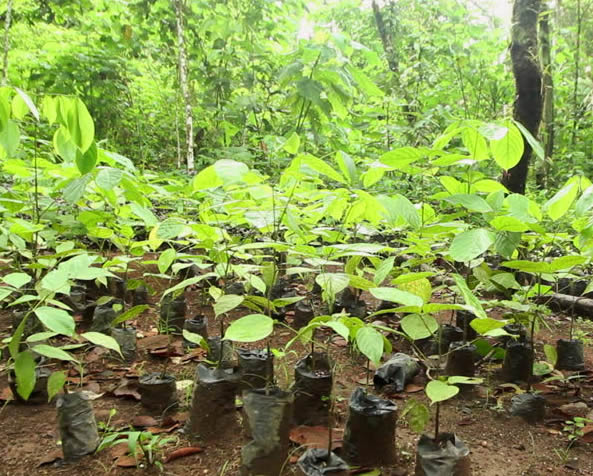 |
| Reforestation |
Reforestation is the growth of new trees in an area that has been cleared for human activities. It can occur naturally or be initiated by people.
Many areas of the eastern United States, such as the New England region, reforested naturally in the nineteenth and early twentieth centuries after farmland that had been abandoned was allowed to lie fallow for decades.
After an area has been logged, environmentalists, as well as the commercial logging industry, advocate planting trees rather than waiting for natural regrowth because the process of natural regeneration can be both slow and unpredictable.
  |
In natural regeneration, the mixture of trees in an area may differ significantly from the forest that preceded it. For example, when nineteenth century loggers clear-cut the white pine forests of the Great Lakes region, many logged-over tracts grew back primarily in mixed hardwoods.
Land that has been damaged by industrial pollution or inefficient agricultural practices sometimes loses the ability to reforest naturally. In some regions of Africa, soils exposed by slash-and-burn agriculture contain high levels of iron or aluminum oxide.
Without a protective cover of vegetation, even under cultivation, soil may undergo a process known as laterization. Laterite is a residual product of rock decay that makes soil rock-hard.
 |
| Tree seedlings |
Such abandoned farmland is likely to remain barren of plant life for many years. In polluted areas such as former mining districts, native trees may not be able to tolerate the toxins in the soil; in these cases, more tolerant species must be introduced.
Safeguarding Timber Resources
Reforestation differs from tree farming in that the goal of reforestation is not always to provide woodlands for future harvest. Although tree farming is a type of reforestation (trees are planted to replace those that have been removed), generally only one species of tree is planted, with explicit plans for its future harvest. The trees are seen first as a crop and only incidentally as wildlife habitat or a means of erosion control.
   |
As foresters have become knowledgeable about the complex interactions within forest ecosystems, however, tree farming methods have begun to change. Rather than monocropping (planting only one variety of tree), the commercial forest industry has begun planting mixed stands.
Trees that possessed no commercial value, once considered undesirable weed trees, are now recognized as nitrogen fixers necessary for the healthy growth of other species. In addition to providing woodlands for possible use in commercial forestry, goals of reforestation include wildlife habitat restoration and the reversal of environmental degradation.
Early Efforts
Reforestation to replace trees removed for commercial purposes has been practiced in Western Europe since the late Middle Ages. English monarchs, including Queen Elizabeth I, realized that forests were a vanishing resources and established plantations of oaks and other hardwoods to ensure a supply of ship timbers. Similarly, Sweden created a corps of royal foresters to plant trees and watch over existing woodlands.
These early efforts at reforestation were inspired by the reduction of a valuable natural resource. By the mid-nineteenth century it was widely understood that the removal of forest cover contributes to soil erosion, water pollution, and the disappearance of many species of wildlife.
Ecological and Environmental Aspects
Water falling on hillsides made barren by clear-cutting timber washes away topsoil and causes rivers to choke with sediment, killing aquatic life. Without trees to slow the flow of water, rain can also run off slopes too quickly, causing rivers to flood. For many years, soil conservationists advocated reforestation as a way to counteract the ecological damage caused by erosion.
In the mid-twentieth century, scientists established the vital role that trees, particularly those in tropical rain forests, play in removing carbon dioxide from the earth’s atmosphere through the process of photosynthesis.
Carbon dioxide is a greenhouse gas: It helps trap heat in the atmosphere. As forests disappear, the risk of global warming caused in part by an increase in the amount of carbon dioxide in the atmosphere—becomes greater.
Since the 1980’s, scientists and environmental activists concerned about global warming have joined foresters and soil conservationists in urging that for every tree removed anywhere, whether to clear land for development or to harvest timber, replacement trees be planted. As the area covered by tropical rain forests shrinks in size, the threat of irreversible damage to the global environment becomes greater.
Reforestation Programs
In 1988 American Forests, an industry group, established the Global ReLeaf program to encourage reforestation efforts in an attempt to combat global warming. In addition to supporting reforestation efforts by government agencies, corporations, and environmental organizations, Global ReLeaf and similar programs encourage people to practice reforestation in their own neighborhoods.
Trees serve as a natural climate control, helping to moderate extremes in temperature and wind. Trees in a well landscaped yard can reduce a homeowner’s energy costs by providing shade in the summer and serving as a windbreak during the winter. Global Re Leaf is one of many programs that support reforestation efforts.
Arbor Day, an annual day devoted to planting trees for the beautification of towns or the forestation of empty tracts of land, was established in the United States in 1872. The holiday originated in Nebraska, a prairie state that seemed unnaturally barren to homesteaders used to eastern woodlands.
Initially emphasizing planting trees where none had existed before, Arbor Day is observed in U.S. public schools to educate young people about the importance of forest preservation. Organizations such as the National Arbor Day Foundation provide saplings (young trees) to schools and other organizations for planting in their own neighborhoods.


